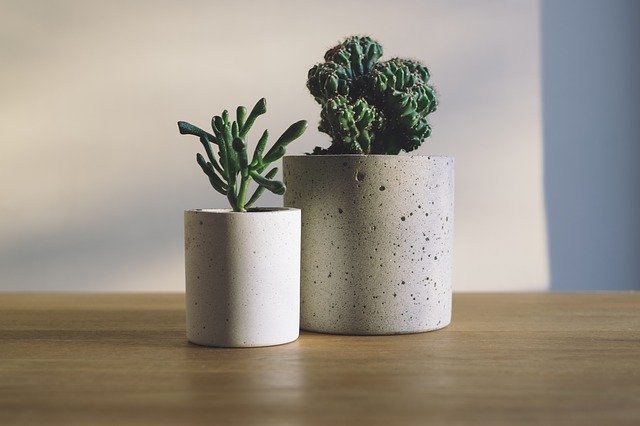You’ve probably seen them everywhere: from home decor magazines to your neighborhood day spa. It comes in different forms in a variety of intoxicating scents that is very distinct from your usual aromatherapy stuff. But is burning incense bad for your health?
The quick answer is yes, burning incense is bad for you. See, studies have shown that certain health problems may be associated with the use of incense, but the potential health risk is highly dependent on the frequency and duration that the person is exposed to the incense smoke, the amount of incense used, and the concentration of the chemical substances that make up the incense being burned.
To understand this, we have to look into how incense is made, what we often use it for, what are its effects on our health and surroundings, and what alternative or safety measures we could do to lessen or eliminate the health hazards that come from incense burning.
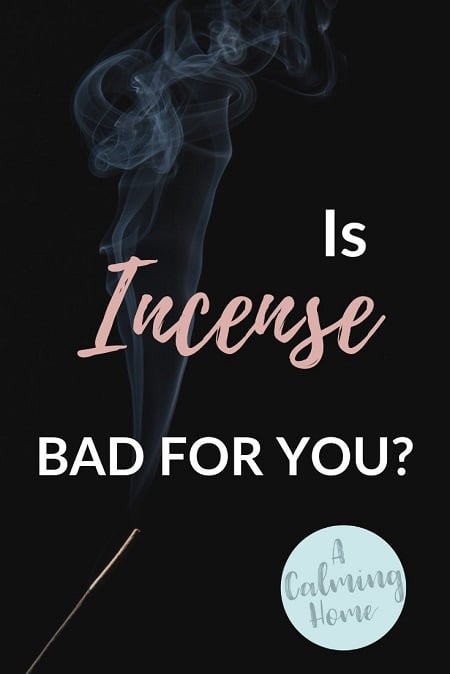
What is incense?
Incense is a spiritual and/or aromatherapy product made up of aromatic ingredients (sweet gums, resins, grounded dried plants and/or other chemical substances) that is burned to emit a fragrant smoke.
According to Merriam-webster, the word incense comes from the Latin word incendere which means “to set on fire” or “to burn”.
There are different kinds of incense and they vary not only in size, shape, and scent, but they also differ in their method of use and their potential health and safety risk.
What is it used for?
They say that incense has been used for as long as man has discovered fire. Perhaps, an accidental inclusion of some dried aromatic plants which produced a desirable fragrant smoke.
From ancient Egypt all the way to the Asian continent, incense played a big part in human history.
Coming from Asia, I’m used to the smell of burning incense because of our numerous religious and cultural practices. But I noticed the rising popularity of incense in western countries in this age of minimalism and mindful living practices.
Nowadays, most people use incense for:
- aesthetics
- to mask unpleasant odors
- to create a pleasant atmosphere
- religious ceremonies
- purification processes
- sacrifice and other ceremonial practices
Are there any health benefits?
From what I can personally concur from the studies that I’ve read, there seems to be more harm to burning incense than the health benefits that come with it.
Contrary to popular belief, incense doesn’t purify the air but adds to the pollution.
Now, most people will argue, what about the hundreds of research about the purifying ability of tea tree or sage?
See, the medicinal qualities do not come from the fragrant smoke but from the healing properties of the botanical plant itself.
The “purification” or “cleansing” concept came from the long history of spiritual and religious background of incense use.
In ancient times, there wasn’t much technology to successfully extract these desirable properties without degrading the quality of the aromatic material.
Times have changed and we have far superior technology and have better means of extracting these therapeutic essences that would not require us to intentionally undergo smoke inhalation.
And this is important because simply saying positive health statements like “it improves blood circulation” or “reduces anxiety” or “aids in sleep” might lead to safety implications for some people.
Saying statements like these are not in any way giving false information, but, incomplete, from what I can say about it.
I’m not saying that I’m an authority in this topic…because I’m not.
But like you, I like asking questions and filling gaps in my knowledge based on real studies and research.
For instance, there are many online claims that incense is all-natural and has no harsh chemicals, and that it would help you relax and make your home smell nice.
While this is partly true, there really is little information on the actual why and how of the issue.
What actually improves your blood circulation?
Is it the smoke from the burning of frankincense incense? or is it from the frankincense resin (extracted from the Boswellia plant) itself?
What actually reduces your anxiety or helps you fall asleep?
Is it really from burning a lavender incense? or is it from the lavender extract in the incense that is being dispersed in the room and sets the aromatic atmosphere?
What’s scary is that there are numerous dangerous statements being claimed online that incense can help you combat different illnesses by “inhaling small amounts of it every day”.
I do not see any health benefits from the burning of incense, but I do see the potential medicinal benefits from the aromatic materials (e.g. herbs, plants) that compose the incense.
There’s a difference.
Remember that every time you’re burning incense, you are not only burning just the aromatic material but other chemical substances as well.
So moving on to our next question,
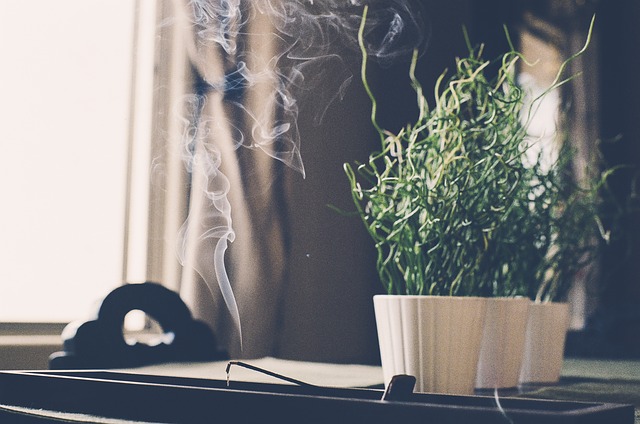
What is incense made of?
This is what most people need to be aware of: there is no standard recipe or procedure in creating “safe” incense for consumer consumption.
There is no governing body to regulate what is safe or not safe to use in the making of incense, and there is no authority to hold a dealer accountable.
Shocking, but true.
We assume that since they’re sold in stores that we trust, that they’re safely tested and regulated and that it is safe to be burned in our homes.
But the fact is, commercial incense (especially the cheaper ones) have questionable ingredients or origins. And you won’t know these because the harmful chemicals are usually labeled as “trade secret” so brands can basically put anything on their packaging and get away with it.
So have you ever asked yourself, why do some people respond well with incense, while others do not?
It all comes down to the quality of the incense that they’re using and their natural bodily responses to it.
For some people, they get headaches or blurred vision, or allergy symptoms like sore throat and itchy skin.
While there are also others, like me, who have difficulty breathing when burning incense, even when we don’t have previous breathing problems, like asthma.
See, we have different sensitivities to different types of particles and chemicals, and our body and immune system recognize what is acceptable or not.
Most incense is made from all-natural, aromatic medicinal ingredients. But there are also other hidden things like sawdust, glue or binding agents, fillers and preservatives.
In a study conducted in 2004, it was said that there are four basal parts of incense, the first two of which, are essential. (Coloring agents, which can be artificial or natural, are also sometimes added.)
1. the aromatic material
The aromatic ingredients may be a combination of various types and parts of plants like wood bark, flowers, gums, resins, seeds, herbs and spices, chosen according to its therapeutic qualities and relief of symptoms.
Both Chinese medicine and Ayuverda medicine believes that the body is made up of five elements. Each of these element is attributed to different parts of the body.
In Ayuverda, the herbal ingredients that comprise an incense may be categorized into five classes.
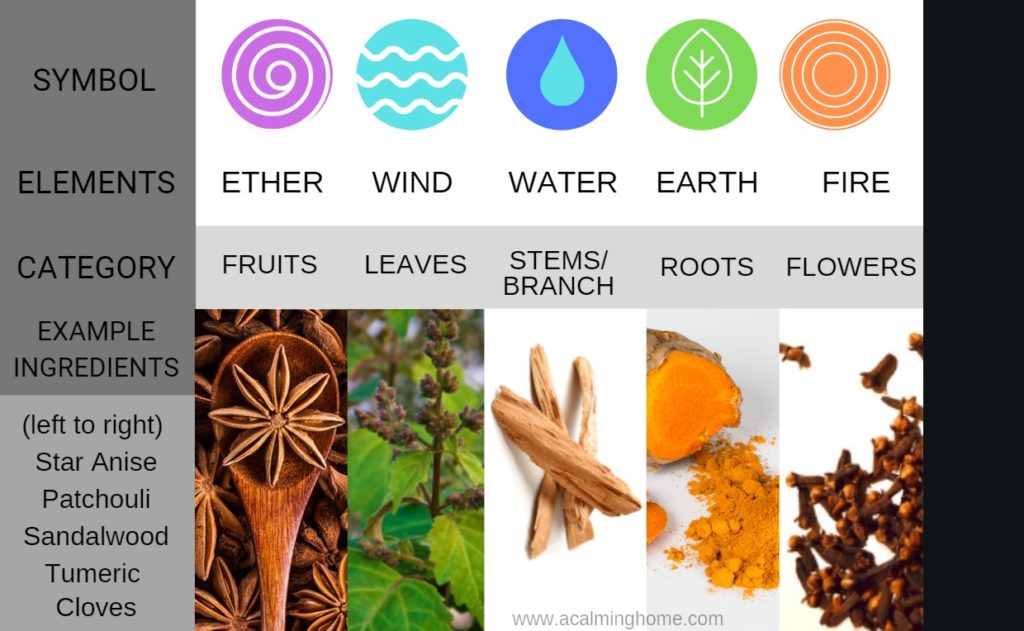
2. a base or substance or aid in combustion
The base must burn easily as most plants cannot burn by itself. According to the study, it’s usually made of odorless powdered wood such as pulverized sawdust (which, I may add, can also come from plywood), sandalwood or other wood variety, needles from evergreen woods.
Additional substances like talc and potassium nitrate can also be added.
Talc regulates the burning rate of incense but can cause respiratory irritation. Potassium nitrate (which can be bought in drugstores), is added for easy ignition and even burning.
3. a binding agent to keep the mixture together
The binding agent is usually made of resin or a similar substance. When Adhesive Powder is used, it’s usually made from the bark of Machilus nanmu Hemsl (Lauraceae).
4. a liquid
Essential oils are normally used, but there is a varying degree of quality in terms of purity. Some cheap incense makers use plain water or floral wastewater left from making the essential oils, while other high-quality incense makers use pure herbal extracts or other creative liquids like wine, brandy, olive oil, and flower tinctures.
What are the health problems caused by Incense?
Now knowing the composition of incense, let’s talk about the health issues that are caused by these substances.
What makes up the incense smoke?
According to a study published in 2008, we must be aware of two things that make incense an indoor pollutant:
1. Particulate Matter
The study reveals that incense produces four times more the amount of particulate matter compared to cigarettes.
The study states that “air particulates are usually categorized according to how deep they can penetrate into the human respiratory system”.
It also states that the finer particles (less than 2.5 µm in diameter) are believed to pose the largest health risks because they can go as deep as the alveoli in the lungs.
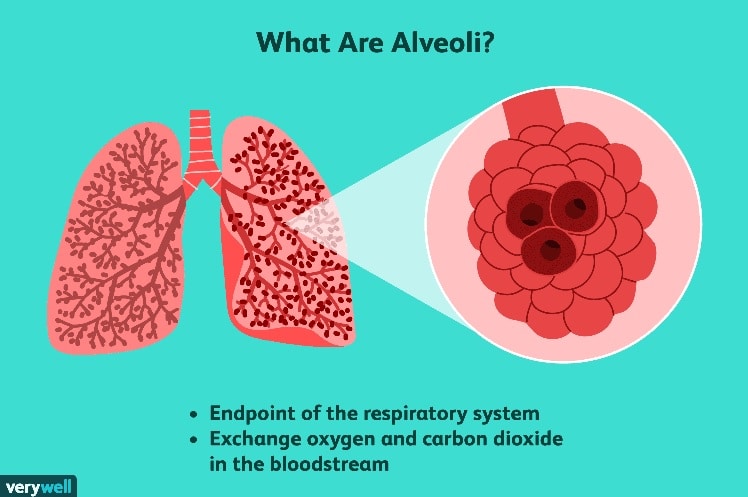
To sum it, the deeper the particulate matter goes into the lungs, the more immediate the threat is to our health.
2. Gaseous Emissions
Everything on this table is from this study unless a source is specified.
| TOXINS IN INCENSE | PROPERTIES | SYMPTOMS |
| Carbon Monoxide | Reduces blood’s capacity to transport oxygen | headaches, dizziness, weakness, nausea (high concentrations can be fatal) |
| Sulfur Dioxide & Nitrogen Dioxide (SO2) & (NO2) |
Aggravation of existing cardiovascular diseases
Effects on pulmonary function respiratory illnesses |
lung irritation alterations in the lung’s defense system |
| Volatile organic compounds (benzene, tol-uene, xylenes, and isoprene) (VOCs) | have low boiling points and therefore evaporate easily at room temperature |
Acute symptoms: eye irritation/watering, nose irritation,
throat irritation, headaches, nausea/vomiting, dizziness, and asthma
exacerbation. Chronic symptoms : cancer, liver damage, kidney damage, central nervous system damage (incense burning generates CO, isoprene and benzene) |
| Aldehydes |
Irritates skin, eyes and the upper respiratory tract Affect nasal mucous membranes and oral passages see: * | Produces burning sensation, bronchial constriction, choking, and coughing |
| Formaldehyde | Potent sensory irritant Classified as a probable human carcinogen Impairs mucociliary clearance | Nasal cancer |
| Polycyclic Aromatic Hydrocarbons (PAHs) | Found in the tar that accumulates in the lungs of smokers (source) |
short-term symptoms such as eye irritation, nausea,
vomiting, diarrhea, and confusion
Long-term health effects may include cataracts, kidney and liver damage, and jaundice Repeated skin contact to the PAH naphthalene can result in redness and inflammation of the skin. Breathing or swallowing large amounts of naphthalene can cause the breakdown of red blood cells. Long-term exposure to low levels of some PAHs have caused cancer in laboratory animals. (source) |
| Diethylphthalate (DEP) | suspect carcinogen | Severe impairment of lipid metabolism coupled with toxic injury to the liver |
*New research found that incense smoke presents many similarities in composition to cigarette smoke. Hence, exposure to incense could potentially have similar effects on the oral environment and on the function and composition of saliva, as observed in tobacco smokers:
- reduction of saliva by the depletion of oxygen
- increased acidity
- decreased activity and abundances of salivary proteins
- lower abundance of Immunoglobulin A (IgA) molecules
This post contains affiliate links for your convenience.
For more information, see my disclosures here.
How to ensure the safe burning of incense
You will need a different safety guide depending on the type of incense that you use. But here is the general rule of thumb when igniting any kind of incense.
Ventilate the Room.
This is an obvious one that needs reiterating. A few companies will include instructions in their packaging and it would mostly suggest burning the incense in a well-ventilated room.
Airing the room will reduce the concentration of combustion residue (that may also cause a fire), as well as the particulate matter and gaseous emissions.
The end effect we want, after all, is the fragrance that remains even after the smoke is removed from the room.
Use smaller amounts or shorter incense sticks.
The more incense that burns, the more smoke and pollutant it emits. By using incense in small increments, you’re able to control and reduce the fumes in your home.
Get medical advice from a health professional.
Depending on your medical case, you will need to talk to your doctor before burning incense.
Incense and Pregnancy.
The body goes through some significant changes during pregnancy, and in this season, you’re not only thinking about your own body but your unborn child’s as well.
You must consider not only the harm from smoke inhalation but also from the medicinal qualities of the plant.
Some aromatic plants have properties that may induce labor, and your baby might also be allergic to some of the materials that make up the incense.
Safe Storage.
Your incense may come with storage instructions. But keep it somewhere dry and out of the reach of small children and pets (this is for both lit and unlit incense).
Inspect the ingredients.
Know the brand you’re using and verify their authenticity. Check their ingredients and know the dangers of each substance.
Consider incense with calcium carbonate added to it. A study suggested that incense that has calcium carbonate can effectively suppress the particulate emission by as much as 40%, which may make the incense safer to use.
Do research on the brand.
Choose high quality organic or all-natural brands of incense. They may be pricier but it will most likely be worth the expense.
A recommended brand by avid incense users are Goloka and Nitiraj.
Some brands are sold by fireworks manufacturers and they usually use cheaper materials that are not suitable for incense making.
We already know that incense is usually comprised of wood dust and fragrant plant oils. Some crooked companies will use wood materials that aren’t suitable for burning.
For instance, incense made with plywood can release formaldehyde when burned. Some incense might use treated wood of chemicals meant for pest extermination.
The fragrant oil can be made of synthetics instead of real herbal essences. The glue can also be made of highly toxic chemicals that they don’t have to disclose to the public.
Do not use charcoal for incense. It may be safe to use outdoors, but when burning indoors, the fumes can get pretty bad.
If you must, a healthier alternative is to use coconut-based charcoal where they use natural gum as binders. It may take longer to ignite but it’s a good alternative to the usual incense charcoal.
For all these reasons it is worth knowing how your incense is made so you can choose those brands that use high-quality materials.
Be aware of some mind-altering varieties of incense.
Incense Vs. Liquid Incense
Do not confuse liquid Incense with regular incense!
According to the National Institute on Drug Abuse, herbal or liquid incense are actually synthetic cannabinoids, which are human-made, mind-altering chemicals that are either sprayed on dried, shredded plant material so they can be smoked or sold as liquids to be vaporized and inhaled in e-cigarettes and other devices.
They are often marketed as “natural” but they are addictive and affect the body the same as marijuana does.
They cause serious mental and physical health problems including:
- rapid heart rate
- vomiting
- violent behavior
- suicidal thoughts
What are the safer alternatives for Incense?
Essential Oils.
Both incense and essential oils are similar in that they are both made from many of the same natural botanical parts such as flowers, leaves, barks and saps, gums, resins, roots, and needles, that are used alone or combined in myriad ways to create aromatherapy products.
The difference lies in their method of use.
Incense can only be used by burning it, which produces fragrant smoke along with particulate matter and gaseous emissions.
The smoke from burning herbs smells different in comparison to the fresh or dried herb itself. I think the smell of essential oils is closer to the real thing because it doesn’t produce fumes.
With essential oils, you can actually use it in different ways depending on the intended purpose.
You can apply it topically (neat or diluted with a carrier oil like olive oil), aromatically ( via a diffuser that disperses the oil molecules in the air rather than burning it, thereby preserving the therapeutic qualities), or internally (by ingesting it with medical supervision).
I always suggest using essential oils first before resorting to incense.
I’ve actually been using essential oils for more than 20 years and I’ve tried so many brands before discovering this brand.
Incense would actually be at the bottom of my list as there are many healthier alternatives.
Air Purifier
They come with different features and purify the air without the harmful smoke. Good quality air purifiers can remove fumes and indoor particles like allergens and pollutants.
Cooking Aromatic Ingredients on Stovetop or Oven
I’m a pastry chef by trade, so this is one of my favorite ways to make my home smell nice.
Bake some goodies or put on some aromatic kitchen ingredients in a pot of boiling water. You’ll benefit from the scent without the worry of indoor toxins.
Air drying aromatic ingredients
When I air-dried bay leaves in our bedroom, the scent lasted while it wasn’t fully dried up. This could be a wonderful idea for other aromatic herbs and plants like rosemary, eucalyptus, lavender, and so much more!
An easy way to air-dry is to just tie a bunch into a bouquet and hang it upside down. This is how it has always been done since ancestral times.
Fresh flowers or fragrant houseplants
Nothing can beat fresh flowers when making a home look lovely and cozy. But sometimes with a mommy budget, it can be a pricey treat.
A good alternative is to care for fragrant houseplants.
We once had a wonderful aromatic house plant in our living room balcony which only bloomed once or twice a year, but when it did, the entire room smelled of this wonderful sweet scent.
Houseplants not only provide aromatic scent to your space but also naturally filters out indoor pollution. I’ve written a post about some hard to kill houseplants that you can start with.
I’ll make a list of aromatic houseplants soon and update this post.
Note: I’ll be updating this post often as soon as new knowledge comes to me. If there are some mistakes in this information, please do let me know so I can correct it for everyone’s benefit. Thank you!
Disclaimer: The statements made in this blog have not been evaluated by the U.S. Food and Drug Administration (FDA). They are not intended to diagnose, cure or prevent any disease. If a condition persists, please contact your physician or healthcare provider. The information provided is not a substitute for a face-to-face consultation with a healthcare provider, and should not be construed as medical advice.


